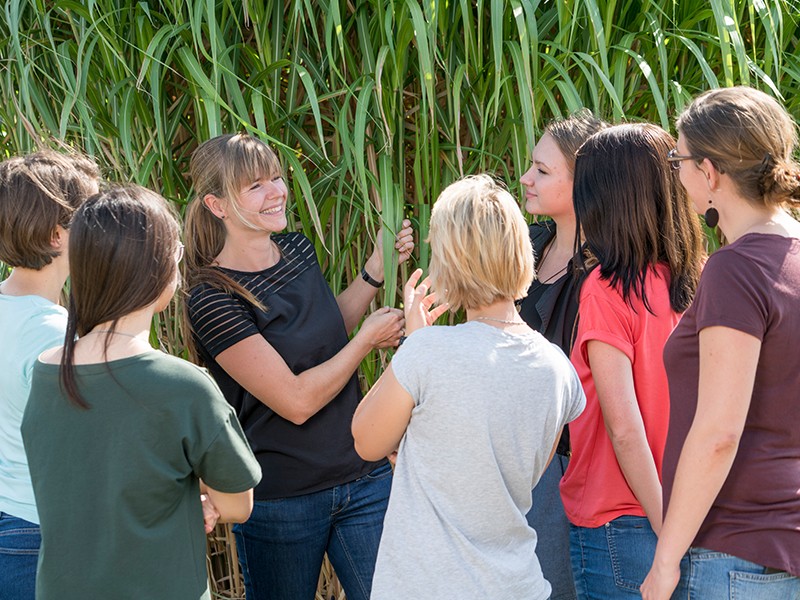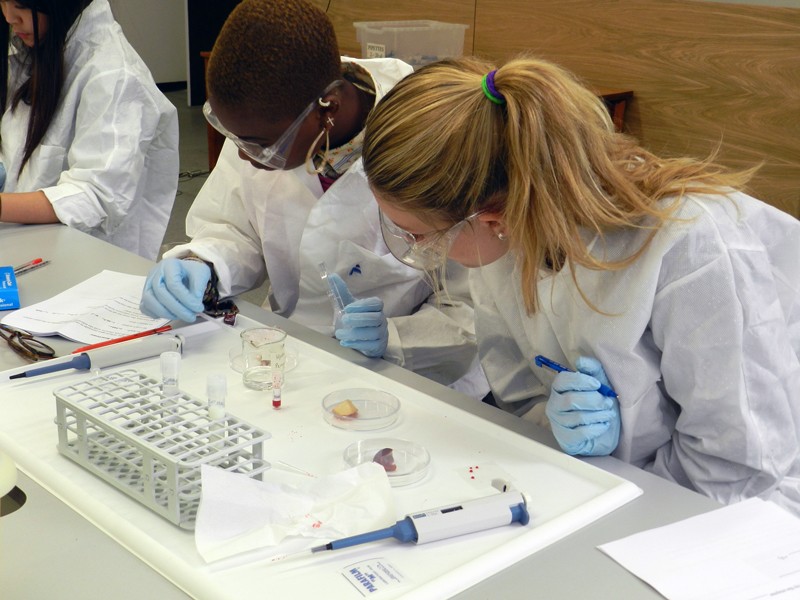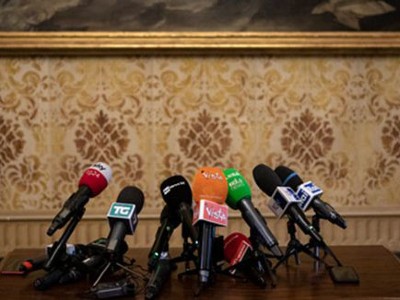With a little help from potatoes, pencils, salt, wires and a battery, undergraduate science students at the Indian Institute for Science Education and Research in Pune embraced its newly digital school-outreach programme in September 2020.
Through video demonstrations by the students, school participants learnt about osmosis by seeing how potatoes shrank or expanded in an overnight saline bath. They discovered how to find the shortest path over round and curved surfaces, and how to make 2D projections of Earth’s surface, using orange peel to simulate the globe.
Such common household items helped the institute’s volunteer Science Nurture Programme to deliver on its mission to support disadvantaged children in their high-school science classes. Before the pandemic forced events online, the programme, which started in 2014, had been running weekly lectures and offering participants visits to local science parks.
Meanwhile, more than 7,000 kilometres away in London, scientists at the Institute of Physics (IOP) took a similar tack, running a series of online video experiments for local primary-school pupils after the pandemic derailed plans to co-create an exhibition with pupils and their families.
The two institutions are far from alone in pivoting to digital schemes for their school-outreach programmes. Pandemic lockdowns around the world have created challenges for researchers who want to inspire the next generation of scientists. Closed laboratories have prevented them from hosting work-experience students, and emptied classrooms and museums have limited or barred opportunities to share stories and experiments in person.
Outreach organizers have been under particular pressure to adopt creative solutions because many programmes are targeted at groups that are under-represented in science, or at schools in deprived neighbourhoods. Students in many such schools have missed out on crucial lab experience because of closures, the challenges of home schooling and cancelled exams.
As happened with conference presenters and university lecturers’ switch last year to virtual sessions and classes, respectively, outreach organizers’ adoption of digital formats was abrupt and unprecedented. But they have learnt that virtual outreach schemes can engage participants just as much as in-person activities can, can offer more flexibility and can also draw larger audiences.
Some outreach organizers are so pleased with the results of their digital programming that they expect to continue to offer hybrid activities that allow both in-person and virtual attendance.
Cancelled trips
Pre-pandemic, the Museum of Life in Rio de Janeiro, Brazil, offered outreach activities such as an ‘Assemble your cell’ workshop, in which primary-school pupils tried to assemble the organelles of a cell inside a plastic bag. For older pupils, the museum performed a play based on music and mathematics. But the two initiatives, along with a truck that took museum exhibits to remote areas, were halted in February 2020. In their place, the museum developed virtual exhibitions on Aedes aegypti, the mosquito that transmits dengue and Zika virus. Later this year, it is planning a vaccination-themed YouTube video series.
Some outreach programmes that involve competitions cancelled them last year so that schools could focus on missed lessons and coursework once they reopened. This is what happened with the South African Agency for Science and Technology Advancement’s national science Olympiad, whose winners would normally get to attend London’s International Youth Science Forum and the Australian National Youth Science Forum. This year, the agency has again cancelled those international trips for winners. But the organization is still running the project and awarding prizes such as laptops, tablets and school vouchers for lab equipment.
The Max Planck Institute of Molecular Plant Physiology (MPI-MP) in Potsdam, Germany, is among organizations that found switching to a digital-outreach format, with videos on topics such as extracting DNA from plants, and online tours of the institution, has boosted participation. Before lockdowns were imposed, the MPI-MP had offered guided tours for high-school students that included garden visits to demonstrate plant-breeding techniques, gene heritability and crop technologies.
The online tours almost doubled the MPI-MP’s website-engagement numbers last year, says spokesperson Ulrike Glaubitz, who notes that the institute’s YouTube following has also risen this year. Glaubitz says that it is uncertain when in-person tours will resume.
Transitioning to an electronic format has also hugely boosted participation in an Indian government awards scheme that aims to spark students’ interest in science careers, and encourage creative thinking by setting up competitions among schools to find one million original scientific ideas.
Before the pandemic, the scheme, known as the INSPIRE Awards–MANAK (Million Minds Augmenting National Aspirations and Knowledge), had been drawing almost four million competitors from across India. That shot up to more than 6.5 million after the programme switched to video and radio offerings. Shortlisted students receive 10,000 rupees (US$137), says spokesperson Sanjay Mishra at India’s Department of Science and Technology, which administers the scheme.
Moving to a virtual format can offer more flexibility, according to Maite Ballestero, who runs the Research Science Institute (RSI), a programme sponsored by the Center for Excellence in Education in McLean, Virginia. The RSI had offered a 5-week research internship for 80 students from the United States and elsewhere at the Massachusetts Institute of Technology in Cambridge. For now, that stint has been replaced by digital interactions that are almost boundless in their scope. “While we cannot do traditional bench science in a laboratory, we are no longer limited by distance or space,” Ballestero says.
She says that the RSI’s offerings in mathematics, computer science and astronomy were not much affected by the new digital format. However, some chemistry and biology experiments had to give way to data science. In 2020, for example, participants developed projects such as an algorithm that can be applied to complex systems in nuclear physics and computer science; analysis of protein data sets from mouse brains to understand a neurodegenerative disorder; and analysis of data on COVID-19 cases and deaths to understand the underlying social determinants. The programme now includes webinars, virtual classes and online guest lectures on natural sciences, maths and engineering.
Digital divides
The IOP’s move to online educational outreach took creative manoeuvring, says spokesperson Claire McLoughlin, because participating pupils had varying degrees of Internet access. “We did not want to simply shift to an online format and carry on as if the world had not radically changed,” she says. “We thought carefully about what we could offer families who were stuck at home and wanting to support their children to learn.”
To bridge the digital divide, they e-mailed activity sheets to teachers to print out and send to children’s homes. Participants then watched videos of experiments and games using cardboard or other recycled objects, including a watering can made from a milk container.
Carrying on in a digital format was also a challenge for the schools-engagement programme of the Kenya Medical Research Institute Wellcome Trust Research Programme (KWTRP), based in Kilifi. Pre-pandemic, the scheme typically engaged with about 4,000 students annually from 50 schools in the East African nation, and organized lab tours, science-career talks and an annual inter-school science quiz. There were also work-experience opportunities for final-year high-school students to gain technical or practical skills at the headquarters of the Kenya Medical Research Institute in Nairobi.
But all of this stopped in 2020. “Since many don’t have access to the Internet [at home], and can only access it through school laptops, online engagement was also not possible while schools were closed,” says Alun Davies, the KWTRP’s schools-engagement lead.
Kenyan schools reopened in January, and the KWTRP piloted online career sessions across ten schools in Kilifi. Davies says that groups of students have been gathering around computers to participate in the sessions, allowing them to engage with researchers in real time, and to view videos about careers related to health research.
To help plug the outreach gap, he says, one colleague developed materials to encourage participating primary schools to establish science clubs. Another colleague helped to produce animations and videos for pupils about COVID-19 vaccine research and contributing to biobanks.
Uneven digital access guided decisions by Fun Lab, a physics programme of the American University in Cairo, around its online outreach offerings. Families without Internet access receive material on CDs, says Mohamed Soliman, science communication officer at the university’s physics department, and a TV channel run by Egypt’s education ministry broadcasts Fun Lab’s science shows, featuring a live audience of 40–50 socially distanced students.
The Francis Crick Institute, a biomedical research centre in London, modified its Primary Science Challenge, run in partnership with UK biomedical funding charity Wellcome and Regent High School, also in London. Primary-school pupils from that part of the city would ordinarily have worked with their teachers in a competition that culminated in giving science presentations at Regent’s theatre. Last year, pupils took part in ‘Science at Home’ challenges instead. Participants could, for example, enter a competition to design a poster with a public-health message, or complete a science-related challenge set by a teacher, with the Crick awarding prizes to the best entries from each school. “Because of the COVID situation, the theatre event wasn’t possible,” says Clare Davy, education manager at the Crick. “We felt it was important to have a competition that anyone could take part in, so long as they could get a piece of paper. Many children in our schools can’t access the Internet and don’t have a lot of sciencey materials at home.”
For students aged 16–17, the Crick turned to Google Classroom to adapt its work-experience opportunities, partnering with Centre of the Cell, a science-education centre based at Queen Mary University of London. Some students worked with the Crick’s communications team to produce a video featuring interviews with Crick scientists about the pandemic. The adapted sessions also covered CV writing and interview techniques.
It is crucial, Davy says, to pique pupils’ and students’ interest in the scientific enterprise by engaging them in practical science. “That is such a motivator for science careers. If we can help to fill that gap, it would be great,” she says.
"how" - Google News
June 07, 2021 at 07:04PM
https://ift.tt/2T6NMuR
How COVID changed schools outreach - Nature.com
"how" - Google News
https://ift.tt/2MfXd3I
Bagikan Berita Ini



















0 Response to "How COVID changed schools outreach - Nature.com"
Post a Comment